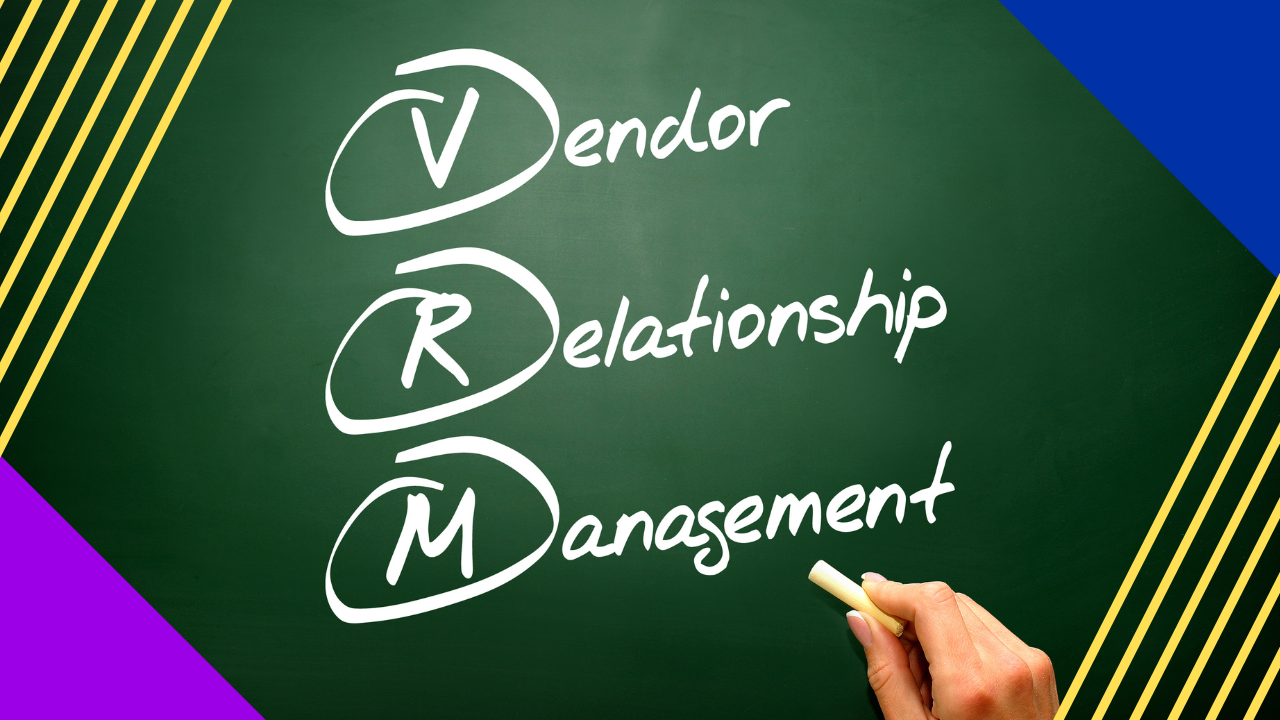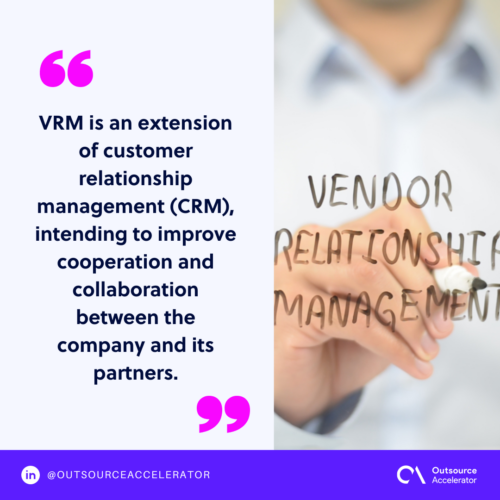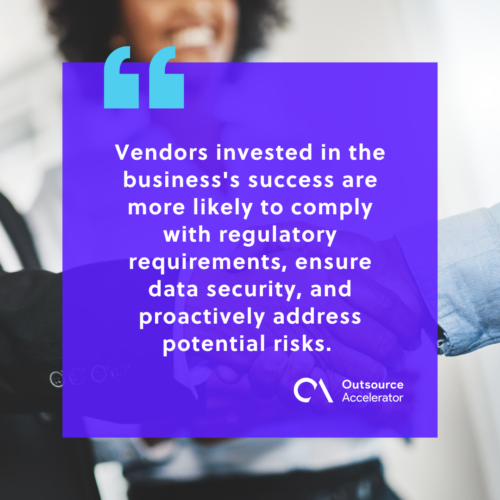10 key strategies for successful vendor relationship management

Maintaining good relationships with vendors is crucial for success in a competitive business landscape.
Vendor relationship management goes beyond simple supplier transactions and fosters collaborative partnerships built on trust, communication, and mutual benefits.
In this article, we’ll explore vendor relationship management’s key strategies, challenges, and benefits. Whether you’re a small business or a large enterprise, this guide will equip you to nurture vendor relationships for long-term success.
Defining vendor relationship management
Vendor relationship management (VRM) is a strategic approach to managing relationships with key vendors. It can be applied to any organization, regardless of size, industry, or geographic location.
VRM is an extension of customer relationship management (CRM), intending to improve cooperation and collaboration between the company and its partners. This aims to achieve mutual benefits like improved customer service, increased profitability, and enhanced competitiveness.
Vendor relationship management encompasses all aspects of acquiring goods and services from vendors. The goal is to provide value to both the organization and the vendor to ensure the relationship remains mutually beneficial.
VRM covers the following:
- Identifying key vendors and their needs
- Developing vendor-specific strategies for each vendor
- Setting up processes for managing each vendor’s performance
- Creating effective communication channels with vendors
- Monitoring performance metrics to ensure that the relationship is meeting expectations
Vendor relationship management is not just limited to vendors that provide goods or services to your company. It also includes partners that could be working with your company on a project or collaborating in some other way.

Vendor vs. supplier: What’s the difference?
Vendors and suppliers are two different types of businesses that provide you with the products or services your business needs.
These differences are outlined as follows:
| Vendor | Supplier |
| Purchases products from a company with the purpose of reselling them to another one | Makes goods available for other companies |
| Considered the last link of a supply chain | Considered the first link of a supply chain |
| Participates in both business-to-business (B2B) and business-to-consumer (B2C) relationships | Exist strictly for B2B relationships |
| In the business of providing items for inventory purposes | In the business of providing raw materials for conversion into products |
| Relationships are usually based on price comparisons | Relationships are focused more on the quality of their goods |
Challenges to effective vendor relationship management
There are several challenges that businesses may face when it comes to effective vendor relationship management.
Some of the common drawbacks include:
Communication issues
Poor communication or miscommunication can hinder effective vendor relationship management. Language barriers, time zone differences, and unclear expectations can lead to misunderstandings and difficulties in aligning goals.
Trust and reliability
Building trust and establishing reliability can be challenging. Trust takes time to develop, and if there have been previous breaches or unreliability, it can impact the relationship and make it difficult to establish a solid foundation.
Cultural differences
Businesses often work with vendors from different cultures and backgrounds in a global marketplace.
Understanding and navigating cultural differences can be a challenge in vendor relationship management. It affects communication, decision-making processes, and overall relationship dynamics.
Vendor performance issues
Managing vendor performance can be challenging, especially when there are multiple vendors involved. Inconsistent quality, missed deadlines, or inadequate support can strain the relationship and impact business operations.
Balancing cost and quality
Balancing cost savings with maintaining quality standards is a constant challenge. Sometimes, opting for the lowest-cost vendor may compromise quality, while selecting a higher-priced vendor may strain the budget.
Contract and legal complexities
Crafting and managing vendor contracts and legal agreements can be complex.
Negotiating terms, ensuring compliance, and addressing potential legal risks can be time-consuming and challenging. This is particularly true when dealing with vendors across different jurisdictions.
Scalability and capacity
As businesses grow or face fluctuations in demand, vendor relationship management needs to adapt accordingly. Ensuring vendors have the scalability and capacity to meet changing requirements can be a challenge.
Data security and privacy
In an era of increasing cybersecurity threats and data privacy regulations, safeguarding sensitive business information and customer data becomes challenging.
Managing data security risks and ensuring vendors adhere to data protection standards requires ongoing monitoring and risk mitigation efforts.
Conflict resolution
Conflicts and disputes are inevitable in vendor relationship management. Resolving conflicts fairly is crucial to maintaining healthy vendor relationships.
However, finding mutually agreeable resolutions can be challenging, especially when differing perspectives and interests are involved.
Vendor consolidation
Large-scale vendor relationship management can be complex. Vendor consolidation efforts to streamline operations and reduce costs may face resistance from vendors who fear losing business opportunities.
10 unfailing vendor relationship management strategies
Here are the top vendor relationship management strategies:
1. Establish clear communication channels.
Open and transparent communication is vital for strong vendor relationship management. Regularly communicate with vendors to ensure mutual understanding of goals, expectations, and any changes in requirements.
2. Foster collaboration and partnership
Treat vendors as strategic partners rather than mere suppliers. Encourage collaboration, share information, and involve vendors in decision-making processes.
This fosters a sense of shared responsibility and strengthens vendor relationship management.

3. Build trust and transparency
Trust is the foundation of successful vendor relationship management. Establish trust by being honest, reliable, and transparent in your dealings with vendors.
Share relevant information and provide feedback on vendor performance to maintain a healthy partnership.
4. Define clear performance metrics
Establish clear performance metrics and key performance indicators (KPIs) to measure vendor performance.
These metrics should align with your business goals and expectations. Regularly review and discuss performance to identify areas for improvement or recognition.
5. Conduct regular vendor performance reviews
Regularly evaluate vendor performance through structured performance reviews.
Provide constructive feedback, acknowledge strengths, and address any performance gaps. These reviews facilitate ongoing improvement and ensure alignment with business objectives.
6. Resolve conflicts promptly
Conflicts and issues are bound to arise during vendor relationship management. Address them promptly and effectively. Foster a problem-solving mindset, listen to vendors’ concerns, and work together to find mutually beneficial solutions.
This helps maintain trust and strengthens the partnership.
7. Recognize and reward vendor contributions
Acknowledge and appreciate vendors for their exceptional performance, contributions, or value-added services. Recognitions can include awards, bonuses, or simply expressing gratitude.
This recognition reinforces positive behavior and encourages continued excellence in vendor relationship management.
8. Mitigate risks
Identify and assess potential risks associated with vendor relationship management.
Develop contingency plans and risk mitigation strategies to minimize the impact of any potential disruptions. Regularly review vendor compliance with regulatory requirements to ensure a risk-averse partnership.
9. Continuously improve
Vendor relationship management is an ongoing process. Regularly assess and update your strategies, keeping industry trends and changing market conditions in mind.
Embrace innovation and explore new technologies that can streamline vendor management processes.
10. Cultivate long-term partnerships
Aim for long-term relationships with vendors to derive maximum value from the partnership. Invest time and effort in building strong bonds based on trust, collaboration, and mutual benefit.
Long-term partnerships often result in better pricing, priority service, and overall performance.
Benefits of better relationship management with vendors
Establishing and maintaining better vendor relationship management can bring numerous advantages to businesses.
Some key benefits include:
Improved supplier performance
Effective vendor relationship management encourages vendors to deliver better performance.
Strong relationships based on trust, clear communication, and mutual understanding drive vendors to exceed expectations in terms of quality, timeliness, and responsiveness.
Enhanced product and service quality
Collaborative relationships with vendors facilitate better product or service quality.
Vendors can better understand the business’s requirements and preferences through open communication channels and shared insights. This leads to improved product design, features, and overall quality.
Cost savings
Strong vendor relationships can result in cost savings for businesses. Vendors who understand the business’s long-term goals and become more invested in its success may offer competitive pricing, discounts, or favorable terms.
Streamlined operations
Successful vendor relationship management promotes smooth and streamlined operations.
Vendors who align with the business’s objectives and processes can integrate seamlessly into the supply chain, reducing bottlenecks, delays, and disruptions.
Innovation and collaboration
Vendors often have industry expertise, insights, and access to new technologies or trends.
By fostering a collaborative environment, businesses can tap into the vendor’s knowledge and benefit from shared innovation. The result is competitive advantages and differentiation.
Risk mitigation
Vendors invested in the business’s success are more likely to comply with regulatory requirements, ensure data security, and proactively address potential risks.
Additionally, with alternative vendor options, businesses can mitigate the risk of relying too heavily on a single vendor.

Flexibility and adaptability
When there is open and transparent communication in vendor relationship management, they can respond more effectively to changes in:
- Demands
- Market conditions
- Unforeseen circumstances
This flexibility enables businesses to adapt quickly and maintain continuity.
Competitive advantage
Businesses can enhance their reputation and customer satisfaction by partnering with reliable vendors who deliver high-quality products or services. Consistently meeting or exceeding customer expectations sets businesses apart from competitors.
Long-term partnerships
Vendor relationship management can foster long-term partnerships, bringing stability, continuity, and trust.
Businesses and vendors can work together to identify opportunities for mutual growth, share risks and rewards, and establish a mutually beneficial partnership.
Customer satisfaction
In the end, greater vendor relationship management results in happier customers. Businesses can consistently meet customer expectations by ensuring the timely delivery of high-quality products or services.
Satisfied customers are more inclined to recommend the brand to others and make repeat purchases.
In conclusion, efficient vendor relationship management is a cornerstone of successful business operations. By investing time and effort into building strong relationships with vendors, businesses can unlock a multitude of benefits and rewards.







 Independent
Independent




